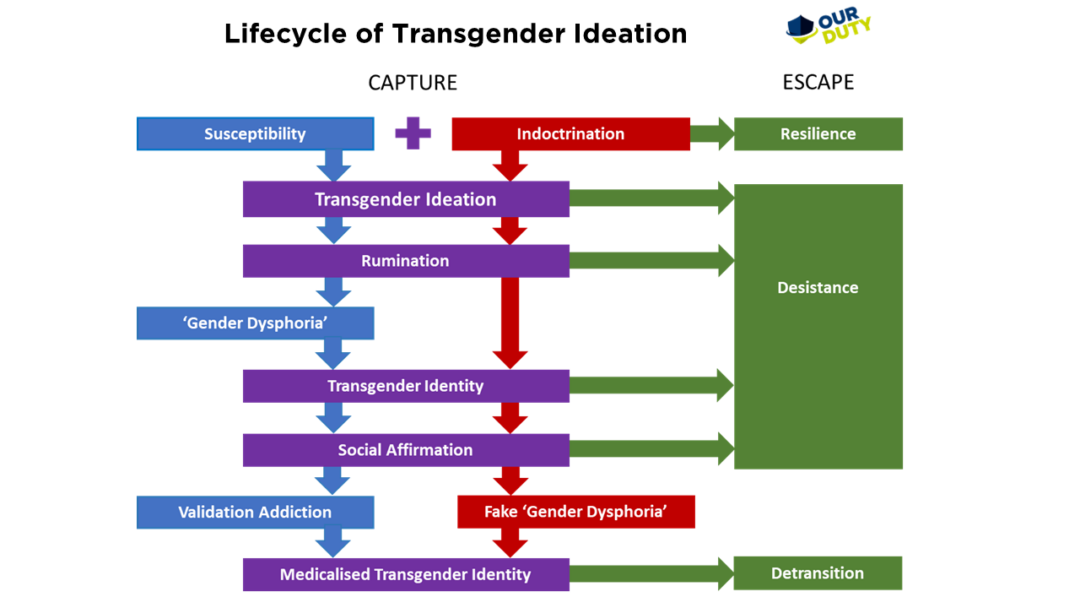It can help to visualise what happens to a young person affected by thinking of themselves as transgender. The above schematic shows that for a child to start thinking of themselves as transgender, to be captured, they must be both susceptible to the idea and be indoctrinated.
Susceptibility
There are a wide variety of factors which can make a child susceptible to the indoctrination that can lead them into thinking that they are transgender. The following list is not exhaustive, but includes the most common factors – often called comorbidities of gender dysphoria.
- Prior Trauma
- Bullying
- Anxiety
- Depression
- Homosexuality
- Neurodiversity
- Discomfort with puberty
- Eating disorder
- Autism
- ADHD
- Sexual abuse
- Giftedness
- Non-conformity with sex stereotypes
- Disability
Other signs to be aware of that can make a child susceptible are:
- Spending too much time online.
- Being in a friendship group that includes others with transgender ideation
- Anime
- Furry fandom
Indoctrination
It is important to note that children will not think of themselves as transgender without it being presented to them as a valid or even likely option to explain their natural feelings of discomfort. In recent years, the whole of society has effectively become one huge machine for the indoctrination of children into transgenderism. What can be termed institutional capture by gender ideology has left no safe space. Right from the promotion of gender identity by the United Nations all the way into primary schools, society is pushing the completely unfounded notion that people who say they are transgender have some special human attribute worthy of recognition and protection in law. For adolescents, being transgender is a social identity, and it has been likened to the ‘goth’ social identities of prior generations.
Resilience
The best thing that can happen to a young person presented with the idea “you might be trans” is to dismiss it with the contempt that idea demands. Instead of promoting gender ideology, schools and wider society need to be promoting critical thinking skills and practical self-improvement customised to the child’s susceptibilities. Parents have a role, too, in helping their children have the confidence to resist and dismiss daft ideas (like the idea that one can become the opposite sex).
Transgender Ideation
Unfortunately, if a child or young person is ill-equipped to dismiss the crazy idea that they might be transgender, they run the risk of adopting that idea as an explanation for their discomfort or angst. Fundamentally, thinking of oneself as transgender is a delusion. A delusion is a belief that is clearly false and that indicates an abnormality in the affected person’s content of thought. The false belief is not accounted for by the person’s cultural or religious background or his or her level of intelligence. We call it transgender ideation because it has similarities with suicidal ideation; both ideations are false beliefs that a course of action will solve perceived problems, and both result in extreme self-harm. Read More
Rumination
Rumination is the act of thinking deeply about something, often to the point of becoming overly focused on it. It is a common trait among people who are prone to anxiety and depression, and it can have a negative impact on their mental health.
Rumination often involves thinking about the same thing over and over again, without finding any resolution or coming to a conclusion. It can be triggered by a variety of things, including stress, worry, or even boredom. Teenagers are prone to rumination, often locking themselves in their rooms for hours on end. This process is greatly worsened by access to spaces online which will contain people all too willing to confirm their darkest and most extreme thoughts. Parents are well-advised to watch for signs of rumination, limit internet usage, and get their kids outside in nature and real-world social settings as much as possible.
‘Gender Dysphoria’
‘Gender dysphoria’ is the name given to the feelings of discomfort a person has once they have convinced themselves that they are transgender. Not every person with the feelings described as ‘gender dysphoria’ has transgender ideation, and not every person with transgender ideation has these feelings. Read More
Transgender Identity
After too much rumination, a child or young person can have convinced themselves that they are transgender and will set about choosing a transgender identity. If this is being done as part of ‘The Script‘ – instructions passed around online by those grooming children into transgenderism – this might start out as a declaration that they are ‘non-binary’. This construct is designed to ease parental acceptance by breaking their ‘transition’ down into fewer drastic steps. Parents might be unaware of what is going on as children will ‘come out’ to their peers – online and at school – long before they do so at home. When this does happen, it is often delivered as a fait accompli and/or by letter. They will ask to be referred to using a new name and with pronouns which are either invented or for the opposite sex. They are likely to throw tantrums and/or use emotional blackmail in an attempt to get their own way. Further evidence of indoctrination by those grooming using ‘The Script‘ will be reinventions of childhood experiences – e.g. ‘I have never liked girly things’ – which are patently untrue.
Desistance
Desistance is the name given to the process of ceasing to identify as transgender before any medical steps have been taken. It should be the objective of every parent and every medical professional working with a young person with transgender ideation to aim for desistance from it. Persistence with a transgender identity can lead to unnecessary medicalisation which itself can lead to permanent physical changes including sterility and loss of sexual function.
Social Affirmation
Social affirmation is the process by which wider society cements transgender ideation in a young persons mind. By going along with their new name and/or using their ‘preferred pronouns’ people are foreclosing normal identity exploration and solidifying the notion that the adolescent is indeed who they say they are. Social affirmation is a grossly irresponsible act that can hinder or obstruct routes to desistance. Sadly, it is advocated for by all those complicit in the indoctrination of our youngsters.
Validation Addiction
A person with transgender ideation tries desperately to convince themselves and those around them that they are the opposite sex to reality. Each time something happens in their life that reinforces their skewed worldview they feel ‘validated’. This provides a physiological reaction deep in the brain as dopamine – the reward chemical – is released. Human brains are hardwired to seek this high, it is a fundamental part of being human, it is what motivates us. This feelgood buzz is also profoundly addictive. Designers of the software that powers the most successful computer games and social media sites know this – it is why Twitter (now X) and Candy Crush are so successful. A person with transgender ideation, if socially affirmed, can become addicted to that external validation. Humouring their delusion is as harmful as giving them heroin.
Fake ‘Gender Dysphoria’
Fake ‘Gender Dysphoria’ is yet another product of ‘The Script‘ used to groom young people into transgenderism. A young person might not actually have ‘gender dysphoria’ as defined in medicine. However, they know how to pretend that they have it because they have been told how. In jurisdictions where a young person has to be diagnosed with ‘gender dysphoria’ to gain access to medical interventions such as prescriptions of opposite-sex hormones, they just fake it.
Medicalised Transgender Identity
The medicalisation of transgender identities is clearly unethical. However, because of widespread ideological capture of institutions including medical professional bodies, such malpractice is widespread. Medical treatments usually start with drugs to stop puberty (puberty blockers) and/or opposite-sex hormones. The purpose of these treatments is to facilitate the imitation of the opposite sex through changes to secondary sex characteristics. Testosterone administered to a girl will lower her voice and promote facial hair growth. Victims will also seek surgical alterations, for example bilateral mastectomies for adolescent girls seeking a more masculine looking chest.
In due course, this unethical medical malpractice will be recognised for what it is. Unfortunately, the changes necessary to bring about a cessation of opposite-sex imitation medicine are slow and patchy. All the while such treatments are available, young people are at risk of irreversible harm.
Detransition
Detransition is the name used for the process of rejecting a transgender identity after that identity has been medicalised. While detransition is commonly associated with transition regret, the two are separate. A person who regrets their medical transition might not detransition, for example if the changes are so irreversible that they will never ‘pass’ as their sex. Detransition does make sense for the vast majority of those with a medicalised transgender identity because living the truth is easier than living a lie and because any further medicalisation necessary will be aligned with their body’s needs (rather than opposed to them). Furthermore, this effect of minimising medical harm is greater the sooner it can be achieved. This is why detransition should be encouraged for every person with a medicalised transgender identity.

